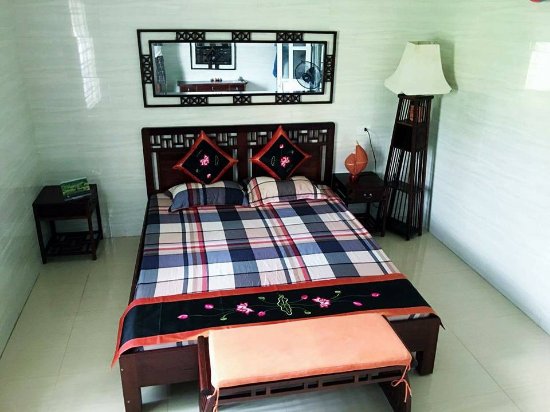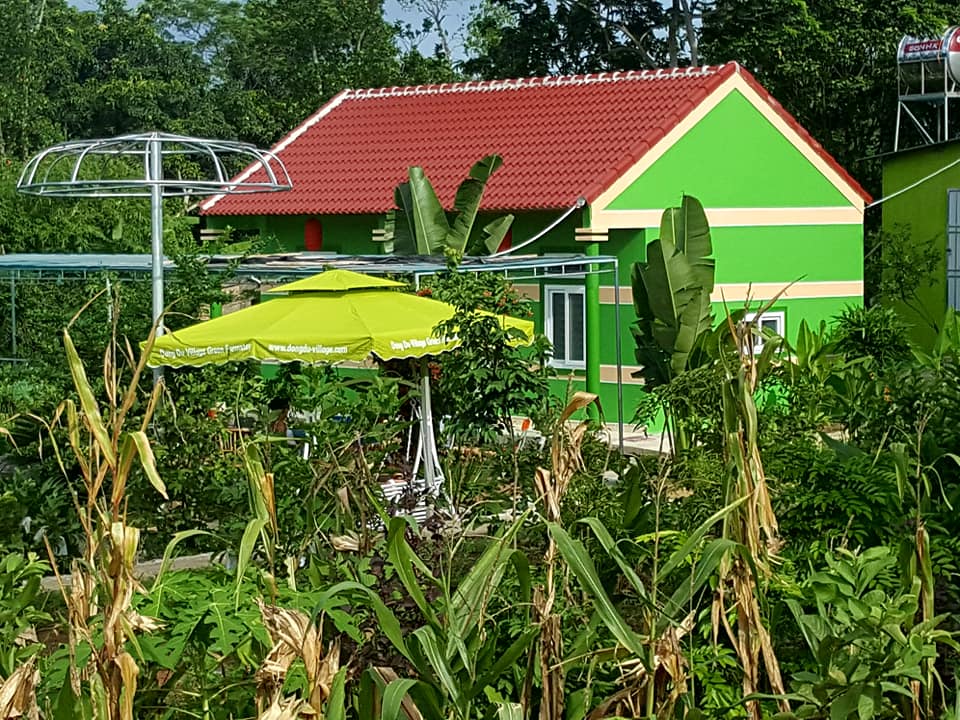Travel Blog
Dong Du Village Lakeside Farmstays
Textiles of Vietnam
Updated: 27/7/2018 | 11:32:02 PM
Vietnam has a centuries-old tradition of silk weaving and embroidery. In Vietnam during feudal times silk was considered an extreme luxury. Associated with nobility, silk was worn only by Kings, queens and mandarins. Vietnam's various dynasties developed strict rules concerning colour, ornamentation, style and fabric of clothes worn by aristocrats.
The clothes worn by Vietnam's nobles featured the royal symbols of dragons, phoenixes, tortoises and cranes-that adorned the robes of Chinese aristocrats. Yet the garments themselves were constructed differently, incorporating elements of traditional Vietnamese design. Vietnam's Nguyen emperors (1802-1945), for example, wore high-necked long con (grand audience) and long chan (formal military gowns, similar to the traditional Vietnamese ao dai tunics that are popular today. Golden hues were reserved for the emperor, as were five-clawed dragons - both symbols of imperial rule.
Vietnam's best silk came from the area of Ha Tay, south-west of Hanoi in the Red River Delta. Silk from this area is often called "Ha Dong silk". The art of silk weaving is said to have begun in Ha Tay as long as 2,000 years ago. Between the 16th 18th centuries, Ha Tay's silk industry flourished. Many villages still bear the name La - the Chinese word for 'silk'. The most famous villages of all were Tring Tiet and Van Phuc, both of which still produce silk today. Today, residents of traditional silk villages like La Ca, Trieu Khuc and Van Phuc are still producing silk, although both the techniques and the quality of the cloth have changed. In Van Phuc, 12km southeast of Hanoi, generators and mechanised looms have replaced handlooms.
About 70 percent of the silk sold in Vietnam is domestically made however some weavers are reviving traditional techniques to turn out high-grade cloth. Twenty percent of the silk exported by Vietnam in 2000 was woven by hand.
My A silk is called as “Queen” of silks and takes over 20 days to create a silk batch. The first stage is the weaving of the cloth with every single thread examined for uniformity to ensure the smooth surface of the fabric. After weaving the silk is soaked, washed, dried, kept with forest resin, dyed, and sun dried twice. The silk is dried in a soft sunlight in order to protect silk from damage. Forest resin for silk soaking must be extracted at the right season in order to make right colour. All the steps are handmade without chemical treatment therefore silk is durable, shinning with the time flow.
Mulberry raising and silk weaving is a traditional craft practiced in Mai Chau is the most developed weaving village for centuries. The life of Mai Chau people has been changed since the 2nd year in Hong Duc’s dynasty (15th century), the northern people came and brought along this trade. Silk & tussore are the specialties of this region . Since 2000, Ma Chau village has achieved great development in quality and quantity to meet the higher market demand. There are 400 households among 600 households in whole village have their own factory with more than 4,000 looms.
Brocade
The Vietnamese brocades are woven in small communities that have a rich tradition of silk weaving. The symbols and patterns are a part of their heritage and history. The purchase of the Vietnamese silks help provide economic growth in small communities. Silk brocade fabrics in a variety of rich, colours, patterns and detail are woven with metallic threads and are generally about 30" wide.
Brocade weaving is practiced by the Cham ethnic group across areas of central Vietnam. Stylized designs are embellished with many types of designs such as: flower, bird, tortoise, gong, jar, elephant’s tusk. The colours have significant meaning in the brocades for example red represents passion and love and yellow meaning the light & the harmony coordination between human and nature.
Embroidery
Embroidery has a long history in Vietnam where different ethnic groups have developed the art over many centuries into a unique form of cultural expression. The art of embroidering on silk was introduced into communities of the north during the 17th century from China. The practice beginning in the northern provinces eventually reached the Old Quarter of Hanoi, where various guilds were set up. In its original form silk embroidery utilised just five colours of thread - yellow, red, green, violet and blue - and was used mainly to adorn temples and pagodas. Read more about Hmong embroidery...
Van Lam is considered to be one of the cradles of traditional embroidery which is very famous in Vietnam. According to village annals, embroidery has existed there for over seven centuries. Currently, of the eight hundred and thirty households in Van Lam, more than seven hundred are skilled in this village industry of making embroidery with lace. The villagers use a multitude of embroidery frames, some as large as a sedge mat, and some as small as a hand. The skilful combination of embroidery and lace from Van Lam continues to be handed down from generation to generation.
The many minority groups of Vietnam also have their own unique embroidery styles. Much of the clothing worn by some of the minority groups such as the Hmong and Dao peoples are elaborately decorated in fine embroidery and braiding. In some pieces the work is so fine that it is almost impossible to tell the front from the back. The Hmong groups also embellish their clothing (which in the past was all made from hemp fibres) with beautiful batik designs.
Lace
By the 19th century silk embroidery had become very popular at the royal court in Hue and during the French colonial period the ancient craft took on a new lease of life when the wives of French officials hired local women to help with their dressmaking. By the end of the 19th century a new class of urban artisans skilled in French-style lace embroidery known as cô khâu đầm (sewing ladies) was emerging in the urban centres, some working directly for French families and others setting up small private tailoring shops of their own. Several rural workshops were later established to make lace for export and by 1930 the northern province of Ha Dong alone had some 4,000 lace makers. With the Great Depression the international market for lace embroidery slumped and machine-made lace was introduced. Today most lace is machine made.
Applique
Appliqué is one of the ways to identify members of the Hmong communities found throughout Vietnam. Ancient techniques have been developed into an art form by the Hmong people the Nghe An province. The art of appliqué is a method of “applying” fabric shapes by hand to produce decorative patterns on a variety of woven products. According to legend, the Hmong people had their own written script but when they were defeated by the Han Chinese they were forced to flee. In order to keep from losing their script, they applied it to their clothing, and this became the well known Appliqué of today. Although their written language has long been lost, variations of their original script can be found throughout Hmong communities and is one way to recognize members of a particular area
Symbolic Stitches - Hmong embroidery
The Hmong people migrated into the Indochina region from China. Although they are not the largest minority group in the region, their beautiful clothing and culture makes them one of the most interesting. The style of their clothing varies from village to village and the colours, decoration and style of their garments denotes the name of their clan for example the Flower, Black, Red and Green and White Hmong.
Skirts, jackets, jewellery, hairstyles and head dresses all vary from clan to clan and village to village. Each village tends to have their own individual style with everyone in the village following the style to the letter. There is no individual style – if one woman changes her dress the entire clan in the village follows.
According to history, the Hmong in China were forbidden to use their ancient Hmong script made up of picture symbols (paj ntaub). So in order to communicate women started sewing the symbols of the script into their skirts, disguising them as patterns in the garments. This practice over time created the distinct and colourful Hmong embroidery style.
Although the methods used in making Hmong clothes have changed over time, with cotton and synthetic fabrics replacing the use of traditional hemp fabrics, the elaborate decoration of the and distinctive skirts and jackets of the Hmong in the remote villages of Northern Vietnam is still prevalent today.
Appliqué, reverse appliqué (Pan dau) and batik are used in combination with cross stitch, chain stitch, running stitch, and a form of satin stitch used to create the symbols and shapes of Hmong designs. Many of the symbols have been stylised and modified into new designs and overtime been interpreted differently by each clan, however the basic shapes of the symbols remain unchanged and are easily identified in the embroidery of all the Hmong clans throughout the region of IndoChina.
The making of clothing and textiles is exclusively left to the women of the family. Every free moment between working in the fields, taking care of the house and the children is spent making clothes and embroidering. From six or seven girls learn to sew and embroider from their mothers, and by the time a girl reaches adulthood she usually has a full trousseau of beautiful embroidered outfits. When a girl reaches a marriageable age she always wears her most beautiful clothes to market or social gatherings to show potential suitors the quality of her sewing. The quality and quantity of clothing a woman has and her ability to sew signifies the wealth and status of her family and is held in high regard when it comes to finding a partner.
Hmong women in the villages of Northern Vietnam like to look elegant at all times. Even when working in the fields a woman will either take an older skirt in a basket to change into, or turn her skirt inside out to protect the skirt and ensure that she always looks at her best coming and going to the fields.
Symbolic embroidery is also used in other household textiles such as baby carriers and children's hats and clothing. Baby carriers are usually given to a bride by her mother to promote the birth of many children and in order to protect a baby's soul, the carrier a long with children's hats are decorated with tufts of brightly coloured yarn, appliqués and embroidered motifs in order to disguise the child as a flower so that evil spirits will not disturb the soul of the child. Mothers also sew symbols and motifs into the collars of a child's clothing to protect it from evil spirits. Symbols are also sewn into the clothing of sharman or healers so that they can 'sneak' good spirits into a room and ward off sickness and evil spirits.
There are several symbols which are recognizable across clans and across countries.
(Source: Dong Du Eco Farmstay)
Other news
- Traditional Textiles villages in Nghe An province
- The treasure of Western Nghe An
- Phu Xai Lai Leng Summit - Nghe An
- Parc national de Phong Nha – Ke Bang
- La beauté des champs de tournesols irrésistible à Nghe An
- Summer Getaway at Pu Mat National Park, Nghe An, Vietnam
- The Western Nghe An Biosphere Reserve
- Réserve naturelle de Pu Luong, trésor caché du Tonkin
- Unique homestay tours delight foreigners in Quy Chau, Nghe An Province
- New nature reserve in Nghe An, Vietnam

















